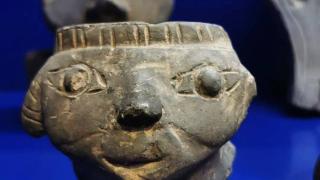- 我的订阅
- 人文
我们正处于一个信息大暴发的时代,每天都能产生数以百万计的新闻资讯!
虽然有大数据推荐,但面对海量数据,通过我们的调研发现,在一个小时的时间里,您通常无法真正有效地获取您感兴趣的资讯!
头条新闻资讯订阅,旨在帮助您收集感兴趣的资讯内容,并且在第一时间通知到您。可以有效节约您获取资讯的时间,避免错过一些关键信息。
【双语视频】走进殷墟⑦丨探寻中国最早的宫殿宗庙遗址
Editor's note: Confirmed by historic documents, archaeological excavations and oracle bone inscriptions as the capital site of the late Shang Dynasty (1600-1046 BC), Yinxu or the Yin Ruins is usually regarded as the cornerstone of the project on tracing the origins of Chinese civilization launched by China in 2001. As a key component of world civilization, it has provided solid evidence for the continuity and pluralistic and integrated pattern of Chinese civilization, bringing recorded Chinese history nearly 1,000 years earlier than previously believed. Starting on October 25, we are launching a series of videos about Yinxu to help you gain a deeper understanding of it. Here is the seventh episode: China's Earliest Imperial Palace & Ancestral Temple Complex.
编者按:作为中国历史上第一个有文献记载并为考古发掘与甲骨文所证实的都城遗址,殷墟是中华文明探源工程的原点和基石,是中华文明连续不断、多元一体的重要实证,也是世界文明史中重要一环。殷墟及甲骨文的重大发现把中国信史向前推进了近千年,同时,因其具有全球突出普遍价值而被列入《世界遗产名录》。为更好讲述中国故事、让世界读懂中国,10月25日起,河南国际传播中心、大河网联合殷墟景区共同推出“走进殷墟”双语系列报道。今日推出第七期:《探寻中国最早的宫殿宗庙遗址》。
Yinxu was the ruins of the capital of the late Shang Dynasty. In 1300 BC, Shang King Pan Geng moved his capital to present-day Xiaotun village in Northwest Anyang city of Central China's Henan province. The capital city, known as Yin, witnessed the succession of 12 Shang kings over 8 generations in 255 years. The palace and ancestral temple area, covering about 700 thousand square meters, is a key component of Yinxu. Archaeological excavations of the palace and ancestral temple area began in 1928. About 100 rammed-earth foundations have been discovered, which were built for palaces, ancestral temples, altars, moats, etc. Besides, not only the remains of craft production workshops, oracle bone pits, sacrificial pits and noble cemeteries, but also vast quantities of oracle bones, bronze vessels, jade articles and other precious artifacts were discovered. Chinese archaeology burgeoned at Yinxu.
殷墟是商代后期的都城遗址。公元前1300年,商王盘庚迁都于今河南省安阳市西北小屯村一带,史称“殷”,历经8代12王,共255年。宫殿宗庙遗址是殷墟的主要组成部分,总面积约70万平方米。考古发掘始于1928年,发现夯土基址100余座,既有宫殿、宗庙、祭坛、防御壕沟,还有作坊、甲骨窖穴、祭祀坑和贵族墓地等,出土了大量甲骨、青铜器、玉器等珍贵文物。可以说,殷墟就是中国考古学的发轫地。(赵汉青 杨佳欣)
推荐阅读
【双语视频】走进殷墟①丨认识中华文明从安阳殷墟开始
【双语视频】走进殷墟②丨甲骨文:世界了解中华文明的“信使”
【双语视频】走进殷墟③丨后母戊鼎:青铜器里的终极大BOSS
【双语视频】走进殷墟④丨甲骨窖穴:中国最早的图书馆和档案库
【双语视频】走进殷墟⑤丨车马坑:中国最早的车马实物和道路遗迹
【双语视频】走进殷墟⑥丨妇好墓:中国最早的女将军墓
编辑:王晓颖
以上内容为资讯信息快照,由td.fyun.cc爬虫进行采集并收录,本站未对信息做任何修改,信息内容不代表本站立场。
快照生成时间:2023-10-31 23:45:01
本站信息快照查询为非营利公共服务,如有侵权请联系我们进行删除。
信息原文地址:



















